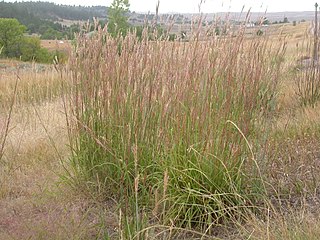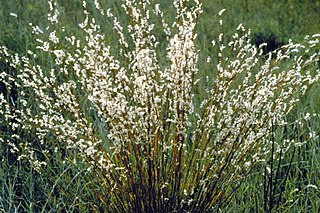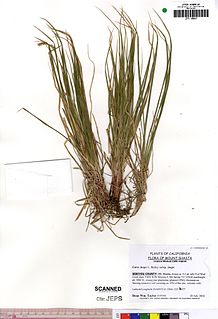Dry–mesic prairie is a native grassland community made up mid-to-tall grasses and a diverse mixture of forbs. The sandy loam or loamy sand soils of Dry-mesic Prairie support grasses that are shorter and grow less densely than Wet-mesic and Wet Prairies. Big bluestem, little bluestem, Indian grass, and porcupine grass are the most abundant grasses in dry-mesic prairie.

Andropogon gerardi, commonly known as big bluestem, is a species of tall grass native to much of the Great Plains and grassland regions of central and eastern North America. It is also known as tall bluestem, bluejoint, and turkeyfoot.

Schizachyrium scoparium, commonly known as little bluestem or beard grass, is a species of North American prairie grass native to most of the contiguous United States as well as a small area north of the Canada–US border and northern Mexico. It is most common in the Midwestern prairies and is one of the most abundant native plants in Texas grasslands.

Andropogon is a widespread genus of plants in the grass family, native to much of Asia, Africa, and the Americas, as well as southern Europe and various oceanic islands.

The Konza Prairie Biological Station is a 8,616-acre (3,487 ha) protected area of native tallgrass prairie in the Flint Hills of northeastern Kansas. "Konza" is an alternative name for the Kansa or Kaw Indians who inhabited this area until the mid-19th century. The Konza Prairie is owned by The Nature Conservancy and Kansas State University.

Andropogon glomeratus is a species of grass known by the common names bushy bluestem and bushy beardgrass. This bunchgrass is native to the Americas, where it is widespread. It has also naturalized in other areas.

Andropogon virginicus is a species of grass known by several common names, including broomsedge bluestem, yellowsedge bluestem and whiskey grass. It is native to the southeastern United States and as far north as the Great Lakes. It is known as an introduced species in California and Hawaii, where it is weedy.
Nomen illegitimum is a technical term, used mainly in botany. It is usually abbreviated as nom. illeg. Although the International Code of Nomenclature for algae, fungi, and plants uses Latin terms for other kinds of name, the glossary defines the English phrase "illegitimate name" rather than the Latin equivalent. However, the Latin abbreviation is widely used by botanists and mycologists.

Schizachyrium is a widespread genus of plants in the grass family. The name is derived from the Ancient Greek words σχίζειν, meaning "to split," and ἄχυρον, meaning "chaff." It refers to either the glume or the toothed lemmas.

Dichanthium, known commonly as bluestem or bluegrass, is a genus of African, Asian, and Australian plants in the grass family.

Andropogon hallii is a sod-forming perennial species in the grass family, Poaceae. It is a bunchgrass which grows in tufts and can reach 7 feet in height under favorable conditions.

Bothriochloa bladhii is a Neotropic grass in the family Poaceae, found primarily in tropical Africa, and tropical and temperate Asia, and Australia. The type specimen was collected from China by Finnish botanist Peter Johan Bladh. The name of Bladh is honored in the specific epithet.

Andropogon gayanus. commonly known as gamba grass, Rhodesian blue grass, tambuki grass, and other names, is a species of grass native to most of the tropical and subtropical savannas of Africa.

Andropogon ternarius is a species of grass known by the common names split bluestem, splitbeard bluestem, silver bluestem, and paintbrush bluestem. It is native to the southeastern, east-central, and south-central parts of the United States, where it occurs from New Jersey south to Florida and west to Kansas, Oklahoma, and Texas.

Carex inops is a species of sedge known as long-stolon sedge and western oak sedge. It is native to northern North America, where it occurs throughout the southern half of Canada and the western and central United States.

Amphicarpum muehlenbergianum is a species of grass known by the common names blue maidencane, Muhlenberg maidencane, and goobergrass. It is native to the southeastern United States.
Andropogon capillipes is a species of grass known by the common name chalky bluestem. It is native to the southeastern United States as far west as Texas.
Claviceps pusilla, also known as bluestem ergot, is a parasitic fungus primarily of the grass tribe Angropogoneae, particularly those in the tribe referred to as "bluestem". C. pusilla occasionally manifests characteristic triangular conidia which appear to be unique among Claviceps species.
Andropogon distachyos is a species of perennial herb in the family Poaceae. They have a self-supporting growth form and simple, broad leaves. Individuals can grow to 62 cm.












